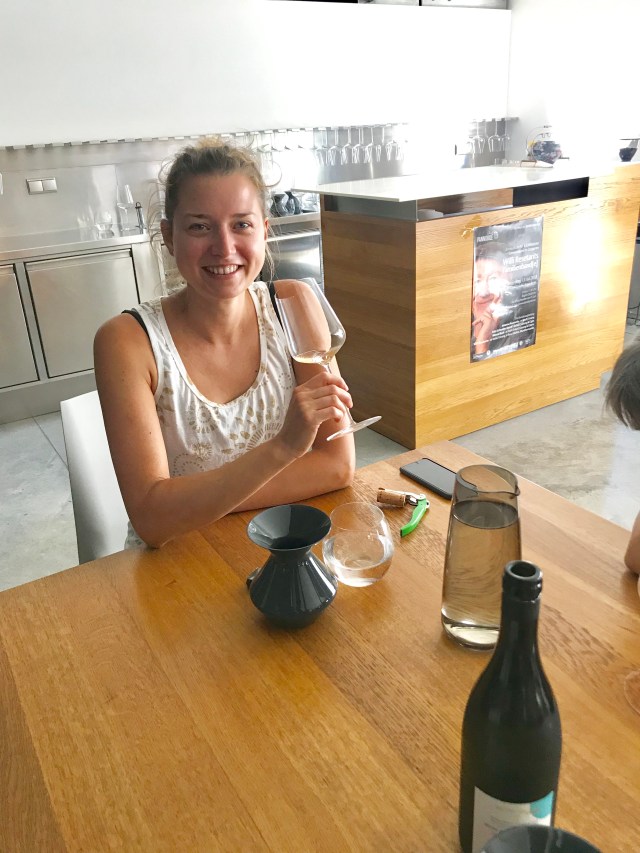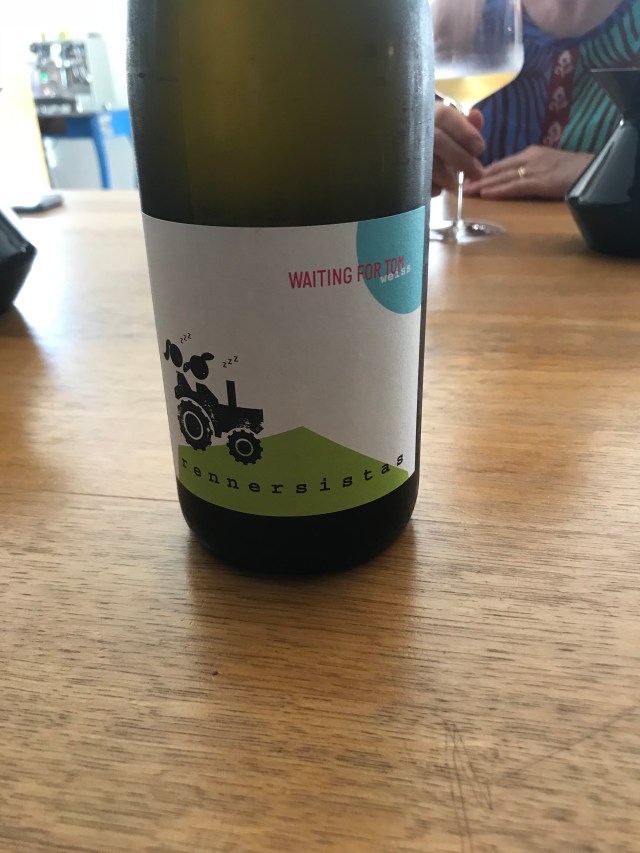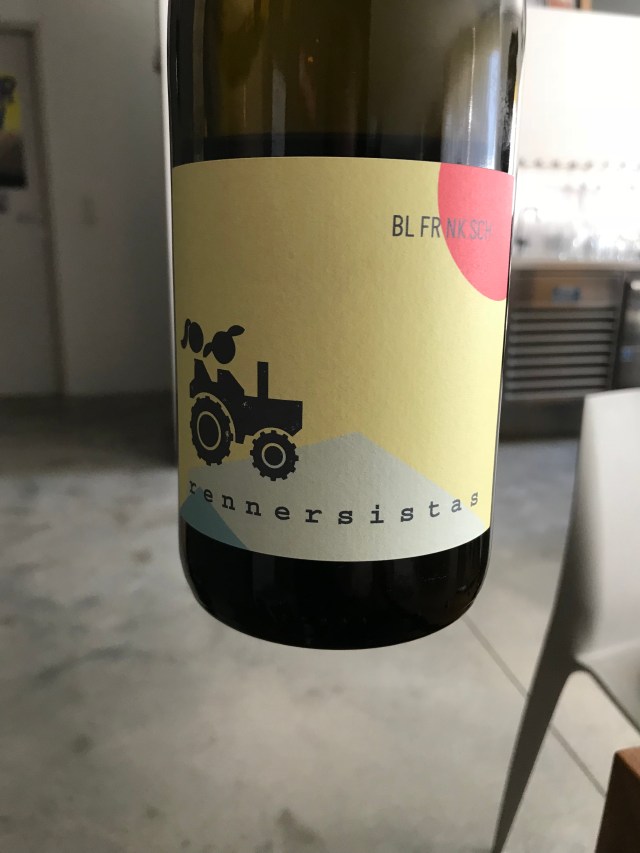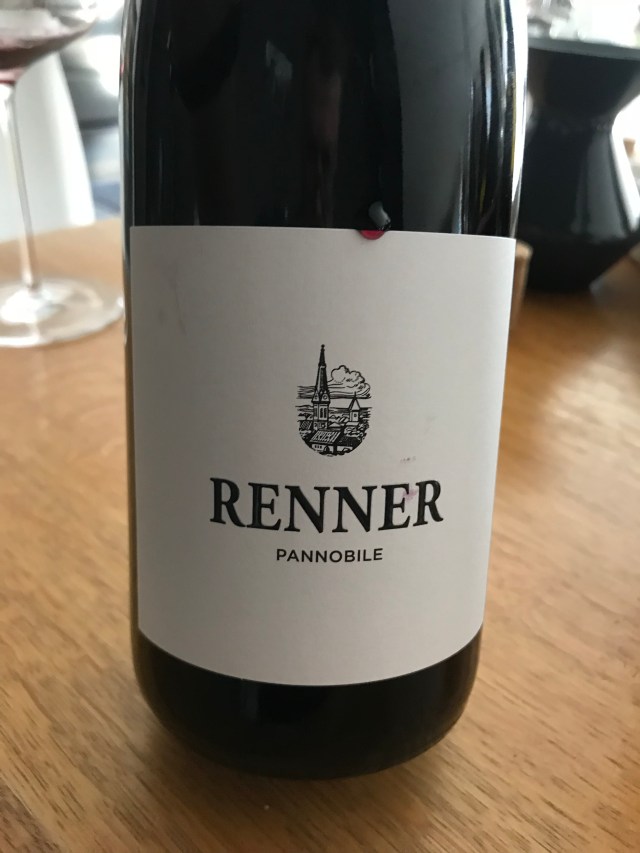Our trip to visit Rennersistas at Gols began very early with a forty-five minute train ride from Vienna Hauptbahnhof to Neusiedl-am-See, and an eleven kilometre cycle into the wind. It made us slightly late and very hot for our 10.30 appointment, but Stefanie’s suggestion that we move directly down into the cellar cooled us off in two minutes. It was a welcome start to a morning spent chatting and tasting with Stefanie Renner, all the more remarkable because it was the first day of the earliest ever harvest at Gols.
I’ve met Stefanie and her sister Susanne several times in London, and regular readers will know that the sisters are among my very favourite producers in Burgenland. The fact that the wines are so exciting is, for me, the prime reason, but at the same time I can’t help being infected by the sheer enthusiasm here.

Rennersistas has grown out of the wine business built up by Stefanie and Susanne’s father, Helmuth, who took over the Renner estate in 1988. He made good wines with, perhaps, a more conservative philosophy than his daughters, relevant to the time. Nevertheless, the domaine’s reputation grew and it joined the nine members of the Pannobile group of quality producers in the village, along with the likes of Preisinger, Beck, Heinrich, Pittnauer, Nittnaus etc (more on Pannobile later).
Eighty-five percent of production for the Rennersistas is currently from red grapes, although they are actively trying to rebalance this, particularly through selling their Merlot which they don’t feel makes good “natural” wine. The gleaming clean cellar, ready to receive the 2018 harvest, is crammed with a mixture of tanks – mainly stainless steel of varying sizes for flexibility, and some wooden fermentation vessels. Four amphorae (1,000 litres each) were due to be delivered days after our visit.
The next level down is the barrel cellar, constructed in 1961, a haven of cool after the building heat of the day outside. Here, rows of mostly used oak sit beneath sandstone quarried on the other side of the lake, providing perfect conditions for élevage. Production under the Rennersistas label began with the 2015 vintage at 5,000 bottles, and is increasing every year.
Stefanie, as many of you will know, trained abroad with Tom Shobbrook in Australia’s Barossa, and with Tom Lubbe (South Africa and Matassa in Roussillon). One or other of the Toms is the origin of the Rennersistas’ increasingly well known wines called Waiting for Tom.
Waiting for Tom White 2017 is a 12% abv blend of Pinot Blanc (Weissburgunder), and Chardonnay. It’s given three days on skins for a touch of colour and texture before being pressed into foudre and some old barriques. It hits you with what is undoubtedly a Rennersistas signature, massive and lively freshness. It has great acidity, but this is totally balanced by fruit. There’s a little spice there as well, perhaps a touch of liquorice.
The sisters began by making mainly single varietal wines. Stefanie said that they really wanted to get to know each variety very well, especially how it performs on its individual terroir, before trying to include them in a blend. But blends seem to be interesting them more and more.

Weissburgunder 2017 is nevertheless a pretty good advert for their single varieties. It may just be a little more “fruity” than the WFT white blend, and maybe a touch “riper” (alcohol level is the same as WFT). This hits first as a hint of apricot but finishes with an equally faint touch of quince. There’s some slate in the soil and perhaps this is what gives the wine a nice edge.
I ought to mention that although freshness seems to be a key component in these wines, they don’t appear to fade. I wrote about their 2015 Weissburgunder almost exactly a year ago, back in August 2017, and it was still delicious, especially as a first attempt.
Waiting for Tom Rosé 2017 is this year a blend of 60% Zweigelt and 40% Blaufränkisch. The fruit again is sweet, but with added spice. And freshness…of course. That fruit is intense strawberry and raspberry, not always associated with Blaufränkisch. The grapes were 100% whole bunch pressed in the coolness of the night time, after picking very early the same morning. Of course, it’s a rosé, it’s not meant to be complex. But the fruit is exquisite, making it just a super nice wine.
Waiting for Tom Red 2017 blends Zweigelt and Blaufränkisch with St-Laurent. In 2016 the vintage was quite cold, with late frost affecting the vines, which stressed the sensitive St-Laurent more than the other varieties. As a result (according to Stefanie) the 2016 WFT red was quite reductive (a carafe to hand would be preferable). 2017 isn’t at all reductive. The St-Laurent was all destemmed for this blend, but a small proportion (around 10%) of the other two varieties went in as whole bunches with stems. It shows the same “gluggable” qualities as the rosé, but naturally with a touch more weight and body.
Blaufränkisch 2016 (technically “BL FR NK SCH” – you can guess the regulatory difficulties with putting a grape variety on the label) is a very interesting wine (note the change of vintage here). From perhaps the late 1980s, and through to the present at some addresses, Blaufränkisch came to be vinified as a quite powerful red in Burgenland, with plenty of extraction and invariably more than a few lashings of oak, much of it new.
There is by chance a very interesting article in the September 2018 Decanter Magazine by Stephen Brook on Blaufränkisch, where he highlights the different possibilities the variety gives the producer: a “weighty, powerful wine…further enhanced by oak ageing” or an unoaked, lighter wine with “bright, zesty sour cherry aromas and flavours”. Whilst I can sometimes appreciate the former style, for sure, it is the latter that I adore for normal drinking, and wines made in this style are often fantastic in their own right, not “lesser” versions of the variety.
The key to freshness is, of course, the avoidance of drowning the fruit in new oak, but equally important is to pick slightly earlier in order to avoid the higher alcohol levels too much hang time will give you. The Rennersistas 2016 Blaufränkisch is pretty much a textbook version of this style. It’s darker than the WFT red, and has thicker legs, but it reaches just 13% abv. It’s not significantly lower in alcohol than the oaky style usually gives us, but it’s enough to make a difference in balance. The bouquet is intense and reflects the darker colour, but don’t fear, freshness, that stamp of this winery, is there as well. Perfect. You can drink a bottle of this, no worries.

Stefanie is quite effusive at this point. She cares deeply about the wines and I think is quite pleased to experience our level of appreciation at close quarters, without the noise and bustle of the Wine Fairs. She says it’s all about the “positivity and love” you put into the wine, a statement which could seem trite coming from some, but in her case you do not doubt that she’s telling the truth. Effusive passion for the wine seems infectious around the lake. You hear exactly the same from Heidi Schröck, Judith Beck, Birgit Braunstein and Stephanie Tscheppe (of Gut Oggau), to name just a few other producers who seem steeped in empathy for their terroir.
Near the beginning of this article I mentioned the Pannobile Group. I should say a few words about them because it is relevant to the final Renner wine we tasted, one which I had never tried before. Pannobile Members submit one red and/or white wine per vintage to be sold under the Pannobile label. It must be made from three red varieties – Blaufränkisch, Zweigelt and/or St-Laurent and two white, Weissburgunder and Chardonnay, but it may be a blend or a single varietal. The stipulated vineyards form a list of the best sites which stretch from Straßäcker, west of Neusiedl’s rail station, to Äussere Söllner-Kranawitzl, east of Halbturn, covering the villages of Neusiedl, Weiden, Gols, Mönchhof and Halbturn.

Weingut Renner Pannobile 2015 comes from the sisters’ first vintage, and they made this prestigious wine with their father. 2015, you will recall, was a very warm vintage, and they persuaded their father to pick a little earlier. Stefanie is not alone in the Pannobile Group in wanting to bring more freshness into the wines, but things must move slowly. The market for this cuvée is overwhelmingly Austrian, and much more conservative than the natural wine loving fans of the Rennersistas wines in the rest of Europe. To symbolise that, it has a different, plain, label to the wonderful “Rennersistas” tractor label, which so perfectly seems to symbolise the sisters’ ethos.
The Pannobile wine, which as we remarked was picked earlier for more freshness, was half aged in 2,000 litre oak and half in smaller wood and barriques (500 litre and 225 litre) for a year. Then it was transferred to tank for six months and saw further bottle age for another six months before release. There are only one or two rackings so the wine here spends a long time on its full lees. The rule is that the Pannobile cuvées can only be sold two years after picking, and the big party that is Pannobile Day has always been held on the first Saturday in September (previously before the beginning of the harvest, but not in 2018!).

What do I think of this wine? Certainly impressive, though quite different to the Rennersistas other wines. In that respect it might shock some. Would I buy it? If the answer were no it would only be because I can’t get enough of their other wines. That said, I’d have bought a bottle to age at home had I not got another thirty-five miles or so to cycle in heat topping 33 Degrees…a decision I now regret.
I mentioned the vintage getting earlier, and the fact that Rennersistas were beginning harvesting on the very day we visited. We are not quite as bad people as it looks, because “harvesting” in this case meant bringing in some grapes for the wonderful petnat “In A Hell Mood”. They tasted ripe from the baskets, and before we left we were privileged to do something all wine writers and wine fanatics dream of. Stefanie scooped up a glass of Pinot Noir juice fresh from the press, and after her, we became only the second and third people to sample what will become the 2018 vintage. Like the sweetest fruit juice and, as is so often the case with just-pressed juice, a reviving glass.
It’s hard to imagine a welcome like that which Stefanie gave us (although another fabulous visit was to end our week in Austria, of which I shall write another time). I had been lucky to chat with Stefanie on several occasions before, so I felt I already had a connection, but I didn’t expect to be made to feel almost like a friend dropping in. Thanks so much, Stef!
We had an invitation to drop in “for a drink” at Claus Preisinger‘s modern winery too, just around a ten minute ride from Weingut Renner. Claus was obviously very busy, with a new team in the cellar receiving the grapes, but we still managed a glass of Kalk und Kiesel 2017, having drunk the 2016 version just three days before at Glacis Beisl in Vienna.
Preisinger is a special name for me. Before I stepped into Newcomer Wines (who import both Rennersistas and Claus into the UK) when they had a container at Shoreditch Boxpark in London, I’d been a fan of Austrian wine, but my focus was mostly on the more traditional whites of the Wachau. It’s probably true to say that Claus, more than any other producer, opened my eyes to the dynamism of the natural wine scene in Austria. Even a short visit was therefore a must, for me. Thanks Claus.
Rennersistas are at Weingut Renner, Obere Hauptstrasse 97, Gols (opposite the petrol station on the very western edge of the village).
Claus Preisinger is at Goldbergstrasse 60 to the north of Gols, and running along one of the village’s most presigious vineyards (Goldberg, of course).
Please make an appointment before visiting. Newcomer Wines at Dalston Junction in London import both producers’ wines.
As a postscript I’d like to give a plug to Neusiedlersee, Europe’s shallowest lake at an average of just 1.5 metres deep. At 315 square kilometres it’s also Europe’s largest endoheic lake (a drainage basin with no outflow). It’s surrounded by an area of reed beds twice the size of the lake itself, and is a haven for bird life. It’s also pretty flat, so ideal for cycling. To be sure, you get a stiff breeze from the southeast (hence the big wind farm north of Gols), but in the heat of a very hot August, this was a blessing.
From Gols we rode to Podersdorf, through flat vineyards (contrasting with the gentle hillsides to the north). From here you can put your bike on a ferry and cross the lake to Rust if you have time. At Rust you can hire small motor boats for an hour or two at the marina, or just cycle to the village to see the picturesque houses and the storks. Oggau is a few kilometres to the north! You can read about my 2015 trip to Rust (Rust Never Sleeps) here.
This time we rode along another cycle route (the region is littered with cycle tracks) back to Neusiedl-am-See and down to the See Bad. Here you’ll find the well known restaurant, Mole West. It sits on a small marina on the lake and whether you’ve cycled 40+ kilometres or not, is a very relaxing place to finish your day. Mole West, Seegelände 9, 7100 Neusiedl-am-See.

We hired bikes (€15 a day each) from Fahrraeder Bucsis, who are right next door (50m) from Neusiedl Station. Direct trains to and from Vienna Hauptbahnhof run hourly, other services requiring a change. Be sure to get into the correct carriages at Vienna because the train splits en route. You can get to Gols by bus, and occasionally by train with a change.






























